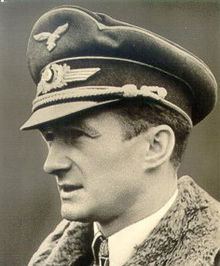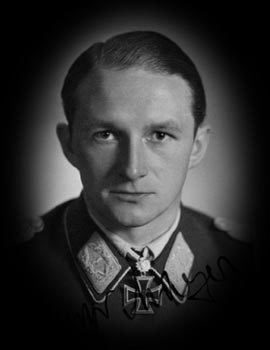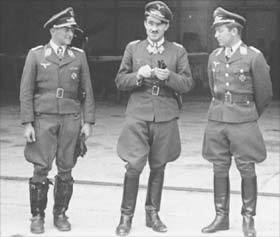Place of burial Normandy, France Years of service 1937–44 | Name Egon Mayer | |
Born 19 August 1917Konstanz, Germany ( 1917-08-19 ) Buried at German War Cemetery St. Desire de Lisieux, Normandy Commands held 7./JG 2, III./JG 2, JG 2 Battles/wars World War IIBattle of FranceBattle of BritainWestern FrontDefense of the Reich Died March 2, 1944, Montmedy, France Battles and wars | ||
War thunder fw 190 a5 f8 ace day 2 egon mayer german
Egon Mayer (19 August 1917 – 2 March 1944) was a German fighter pilot during World War II. He was credited with 102 enemy aircraft shot down in over 353 combat missions. His victories were all claimed over the Western Front. Mayer was the first fighter pilot to score 100 victories entirely on the Western Front.
Contents
- War thunder fw 190 a5 f8 ace day 2 egon mayer german
- who is the unaffiliated jew egon mayer
- Early life and career
- World War II
- Group commander
- Wing commander and death
- Awards
- References

Born in Konstanz, Mayer, volunteered for military service in the Luftwaffe (air force) of Nazi Germany in 1937. He was posted to Jagdgeschwader 2 (fighter wing, JG 2) in 1939. He fought in the Battle of France and claimed his first aerial victory in that campaign on 13 June 1940. Mayer was appointed squadron leader of the 7th squadron of JG 2 in June 1941. Two months later, following his 21st aerial victory, he received the Knight's Cross of the Iron Cross on 1 August 1941. In November 1942, Mayer was appointed commander of the III. Gruppe (3rd group) of JG 2.

Mayer claimed his first victories over United States Army Air Forces (USAAF) four-engine bombers on 23 November 1942. Together with fellow pilot Georg-Peter Eder, Mayer developed the head-on attack as the most effective tactic against the Allied daylight heavy combat box bomber formations. He received the Knight's Cross of the Iron Cross with Oak Leaves on 16 April 1943 after 63 victories. On 1 July 1943, he was appointed commander of JG 2. On 5 February 1944, Mayer became the first pilot on the Channel Front to reach 100 victories. He was killed in action on 2 March 1944 while leading an attack on a USAAF bomber formation; he was shot down near Montmédy, France. Mayer was posthumously awarded the Knight's Cross of the Iron Cross with Oak Leaves and Swords.

who is the unaffiliated jew egon mayer
Early life and career

Mayer, the son of a farmer, was born on 19 August 1917 in Konstanz at the Bodensee. Konstanz at the time was in the Grand Duchy of Baden of the German Empire. Mayer grew up on his parents' farm named Hauserhof and spent his spare time at the glider airfield at the Bellenberg near Engen. He went to school at the Langemarck-Realgymnasium—a secondary school built on the mid-level Realschule to achieve the Abitur (university entry qualification)—in Singen. Today, the Langemarck-Realgymnasium, which had been named after the location of the World War I Battle of Langemarck, is the Hegau-Gymnasium.

Following his graduation, Mayer volunteered for military service in the Luftwaffe on 1 November 1937. His military training began at the 2nd Air Warfare School (Luftkriegsschule 2) at Gatow, on the southwestern outskirts of Berlin. He was then trained as a fighter pilot and promoted to Leutnant (second lieutenant) on 1 August 1939.
World War II

World War II in Europe began on Friday, 1 September 1939, when German forces invaded Poland. Mayer received the Iron Cross 2nd Class on 25 October 1939 and was transferred to Jagdgeschwader 2 "Richthofen" (JG 2—2nd Fighter Wing), named after the after World War I fighter ace Manfred von Richthofen, on 6 December 1939. For his entire combat career, with the exception of a brief posting to the fighter pilot school at Werneuchen, Mayer served in JG 2. He claimed his first aerial victory on 13 June 1940 during the Battle of France, shooting down a Morane-Saulnier M.S.406 belonging to the French Air Force (Armée de l'Air).

In the Battle of Britain, Mayer often flew over the English Channel as the wingman of Helmut Wick. He claimed three further victories in this campaign, all over Royal Air Force (RAF) Supermarine Spitfires, but was himself shot down or forced to land at the French Coast. Once he had to swim in the Channel for an hour before he was rescued. At the end of 1940 Mayer had four victories to his credit and JG 2 was withdrawn from combat to replenish the heavy losses it had sustained. Following a short tour as fighter pilot instructor at the Jagdfliegerschule (fighter pilot school) in Werneuchen, Mayer was sent back to the Channel Front.
On 10 June 1941, Mayer was appointed Staffelkapitän (squadron leader) of 7. Staffel (7th squadron) of JG 2, based at Saint-Pol-Brias. He claimed his 19th and 20th victory on 23 July 1941 and was awarded the Knight's Cross of the Iron Cross on 1 August 1941 after his 21st aerial victory. He received the award with fellow JG 2 pilots Oberleutnant Erich Leie and Oberleutnant Rudolf Pflanz on that day. The triple award presentation was recorded by the Deutsche Wochenschau (German Weekly Review), a newsreel series released in the cinemas. His score had increased to 28 aerial victories by the end of 1941.
Mayer received the German Cross in Gold on 16 July 1942. On 19 August, his 25th birthday, Mayer shot down two Spitfires over Dieppe during Operation Jubilee, his 49th and 50th victory.
Group commander
Mayer was promoted to Hauptmann (captain) and was appointed Gruppenkommandeur (group commander) of III. Gruppe of JG 2 in November 1942. On 23 November, Mayer claimed his first victories over United States Army Air Forces (USAAF) four-engined bombers, when he shot down two B-17 Flying Fortresses and a B-24 Liberator. Together with Georg-Peter Eder, Mayer developed the head-on attack as the most effective tactic against the Allied daylight heavy combat box bomber formations. The concept was based on a Kette (chain), three aircraft flying in a "V" formation, attacking from ahead and to the left. When in range, the attackers opened fire with a deflection burst, aiming in front of the enemy aircraft. Following the attack, the pilots would pull up sharply to the left or right. This gave the attacking fighters the best chance of avoiding the massed firepower of the bombers' guns.
On 14 February 1943, Mayer shot down three RAF Hawker Typhoons, claiming his 60th to 62nd victories. Following his 63rd victory he was awarded the Knight's Cross of the Iron Cross with Oak Leaves on 16 April 1943, the 232nd officer or soldier of the Wehrmacht so honored. The presentation was made by Adolf Hitler in his office at the Reich Chancellery in Berlin on 11 May 1943. Mayer was then promoted to Major (major) on 1 June 1943.
In June 1943, Mayer encountered Robert S. Johnson, a future ace from the 56th Fighter Group of the US Eighth Air Force. Johnson's P-47 Thunderbolt had been badly shot-up by some Focke Wulf Fw 190s during a routine mission. As Johnson limped home, with a canopy that would not open and hydraulic fluid and oil covering his windscreen, Mayer pulled alongside him in his Fw 190. Mayer looked the wounded P-47 over, and then circled to come in from Johnson's six-o'clock to give it the coup de grâce. The first gun pass failed to knock the heavy American fighter out of the sky. Mayer made two more runs on Johnson, without success. After running out of ammunition, Mayer pulled alongside Johnson, saluted him and headed for home. Johnson landed his plane, and counted more than 200 holes, without even moving around the airplane. He also saw that a 20 mm cannon shell had exploded just behind his headrest, which had made it impossible to open his canopy.
On 22 June 1943, a flight led by Mayer encountered an RAF Spitfire unit. During the course of the engagement, he claimed one Spitfire shot down and damage to another. He shot down three USAAF P-47s on 26 June 1943.
Wing commander and death
Mayer was appointed Geschwaderkommodore (wing commander) of JG 2 on 1 July 1943, thus succeeding Oberst (Colonel) Walter Oesau. Command of III. Gruppe was passed on to the Staffelkapitän of 8. Staffel, Hauptmann Bruno Stolle. He claimed three B-17s shot down within 19 minutes on 6 September. The Eighth Air Force was targeting Stuttgart that day and lost 45 aircraft. On 1 December 1943, Mayer shot down three P-47 Thunderbolts. His claimed aerial victories increased to 90 on 30 December 1943. Mayer was credited with four victories on 7 January 1944, three B-24s and one B-17 shot down in the vicinity of Orléans. On 4 February 1944 he claimed his 100th victory, the first fighter pilot on the Channel Front to achieve this mark.
Mayer's final score stood at 102 when he was shot down and killed in action by a P-47 Thunderbolt near Montmédy on 2 March 1944. Flying Focke-Wulf Fw 190 A-6 (factory number 470468), Mayer had led his Stabsschwarm (headquarters unit) and elements of III. Gruppe, 14 Fw 190s in total, in an attack on B-17s in the area of Sedan, but failed to detect the fighter escort of 29 P-47s 5,000 feet (1,500 meters) above. His aircraft was seen taking hits at a range of 400 yards (370 meters) in the nose and cockpit. It made a violent snap roll and went into a vertical dive, crashing within 1.5 miles (2.4 kilometers) of Montmédy. He was posthumously decorated with the Knight's Cross of the Iron Cross with Oak Leaves and Swords that day.
Recent research by historian Norman Fortier suggests that Mayer was shot down by Lieutenant Walter Gresham of the 358th Fighter Squadron of the 355th Fighter Wing. The claim is based on gun camera footage and recollections of Mayer's wingman, who was forced to bail out during the action. Mayer was buried at the cemetery of Beaumont-le-Roger, France, and in 1955 re-interred at the German War Cemetery in St. Desiré de Lisieux.
